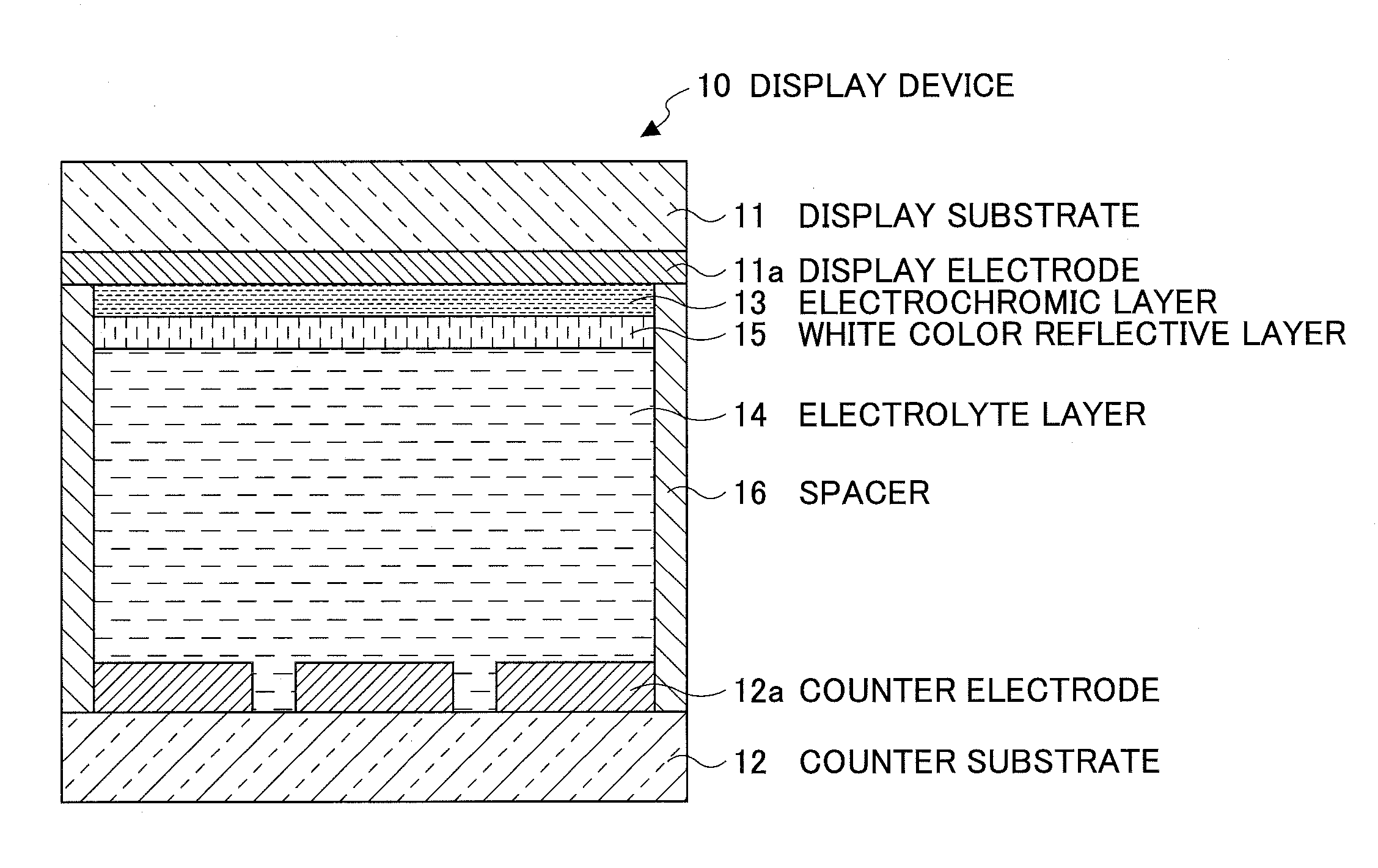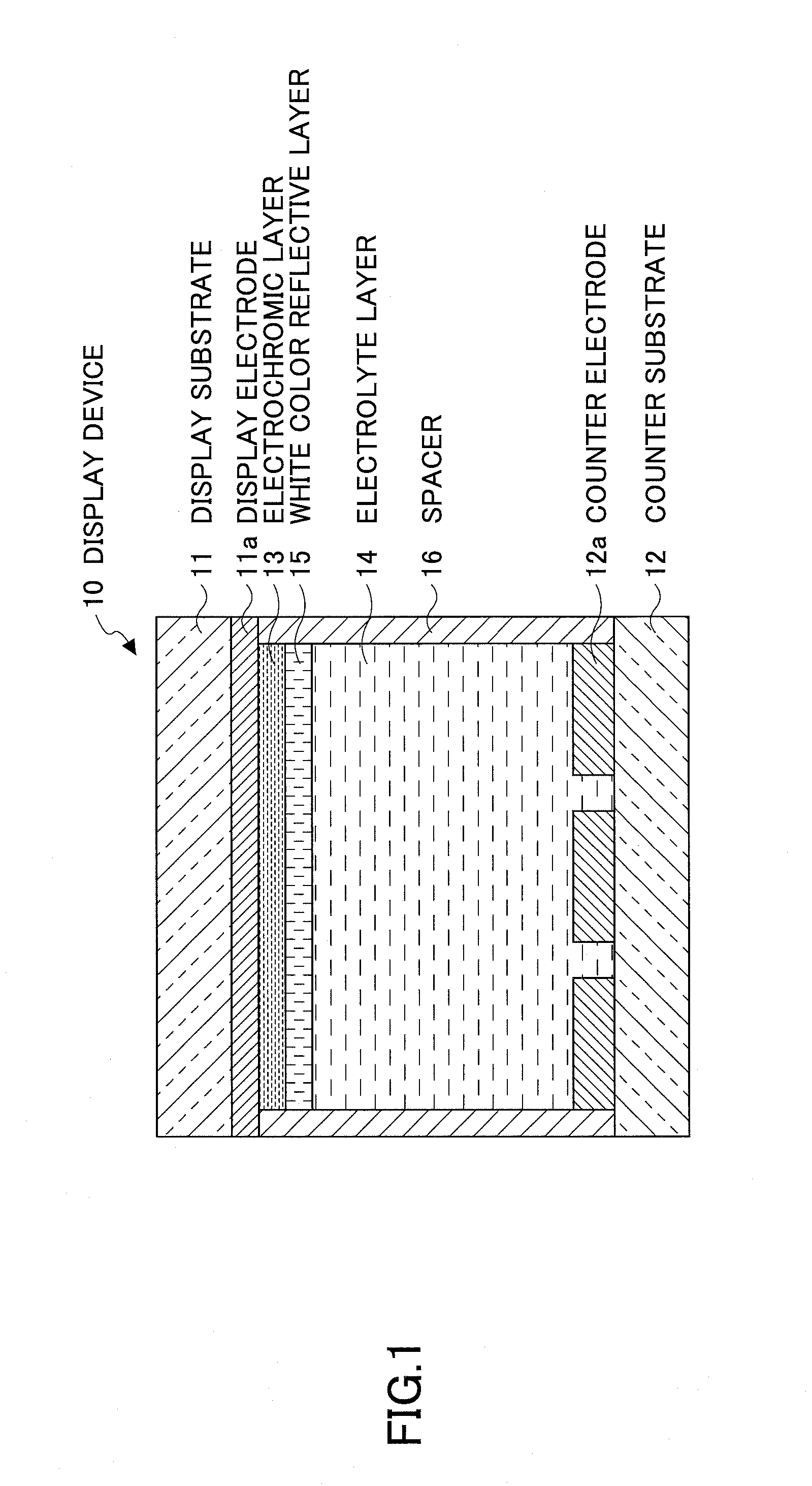Ion conductor and electrochromic display device
a display device and electrochromic technology, applied in the direction of capacitors, basic electric elements, instruments, etc., can solve the problems of slow response speed of electrochromic display devices, difficulty in displaying multiple colors, and difficulty in using display devices such as electronic papers,
- Summary
- Abstract
- Description
- Claims
- Application Information
AI Technical Summary
Benefits of technology
Problems solved by technology
Method used
Image
Examples
example 1
[Manufacturing Electrochromic Display Device]
[0116]As the display electrode, a glass substrate having sizes of 40 mm (vertical) by 40 mm (lateral) and a thickness of 0.7 mm was provided. On this glass substrate, an ITO film having a thickness of approximately 100 nm was formed to form the display electrode 11a.
[0117]Next, titanium oxide particle dispersion liquid (product name: SP210 by Showa titanium Co., Ltd. average particle diameter: approximately 20 nm) was coated using a spin coat method. Then, the annealing treatment to heat at a temperature of approximately 120° C. for approximately 15 minutes was performed to form a titanium oxide particulate film (formed of a nano-structure semiconductor material) having a thickness of approximately 1.0 μm. Next, 2,2,3,3-tetrafluorophloropropanol solution containing 1.5 wt % of compound represented by the following structural formula (3) as the electrochromic compound was applied by the spin coat method. Then, the annealing treatment to h...
example 2
[0133]In Example 2, the display device and the impedance measurement cell were manufactured in the same manner as in Example 1 except that 4-cyano-4′-pentylbiphenyl (product name: C1550, Tokyo Chemical Industry Co., Ltd., molecular weight: 249) as the liquid crystal material of the electrolyte layer used in Example 1 was replaced by a mixture of 4-cyano-4′-pentylbiphenyl and 4-cyano-4′-pentyloxybiphenyl (product name: C1551, Tokyo Chemical Industry Co., Ltd., molecular weight: 267) (weight composition ratio: 7 / 3). Then, the display device and the impedance measurement cell of Example 2 were evaluated. Table 1 further collectively illustrates evaluation results (coloring characteristics, memory characteristics) of the electrolyte layer (liquid crystal material, electrolyte and the like) and display device and evaluation results (impedance, voltage response and the like) of the electrolyte layer cell used in Example 2. As a result, similar to Example 1, it was possible to detect (obse...
example 3
[0134]In Example 3, the display device and the impedance measurement cell were manufactured in the same manner as in Example 2 except that the amount of electrolyte (1.5 wt % mixture) in Example 2 was replaced by a larger amount of electrolyte (2 wt % mixture). Then, the display device and the impedance measurement cell of Example 3 were evaluated. Table 1 further collectively illustrates evaluation results (coloring characteristics, memory characteristics) of the electrolyte layer (liquid crystal material, electrolyte and the like) and display device and evaluation results (impedance, voltage response and the like) of the electrolyte layer cell used in Example 3. As a result, similar to Example 1, it was possible to detect (observe) the coloring / decoloring response, and also excellent memory characteristics were confirmed (observed).
PUM
 Login to View More
Login to View More Abstract
Description
Claims
Application Information
 Login to View More
Login to View More - R&D
- Intellectual Property
- Life Sciences
- Materials
- Tech Scout
- Unparalleled Data Quality
- Higher Quality Content
- 60% Fewer Hallucinations
Browse by: Latest US Patents, China's latest patents, Technical Efficacy Thesaurus, Application Domain, Technology Topic, Popular Technical Reports.
© 2025 PatSnap. All rights reserved.Legal|Privacy policy|Modern Slavery Act Transparency Statement|Sitemap|About US| Contact US: help@patsnap.com



